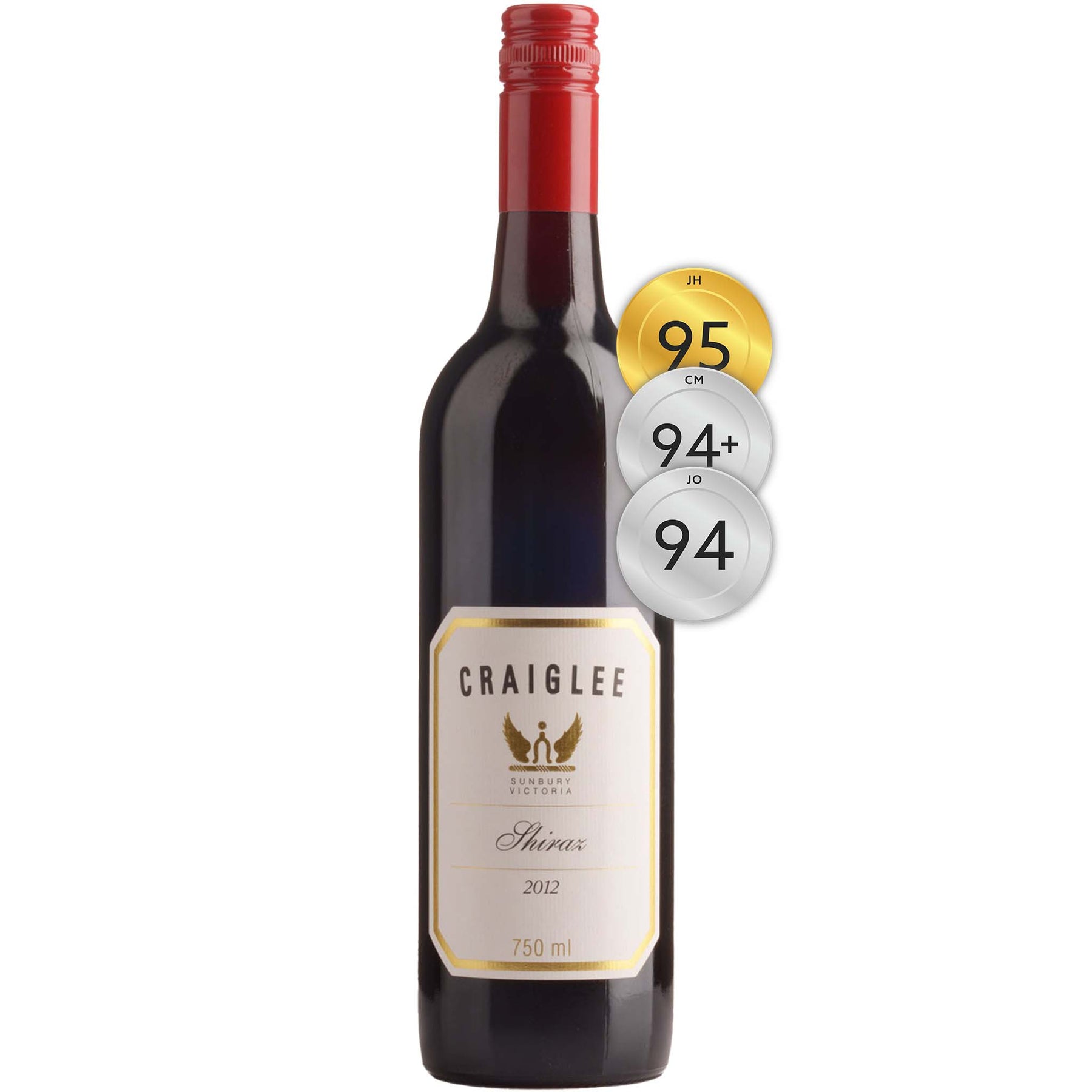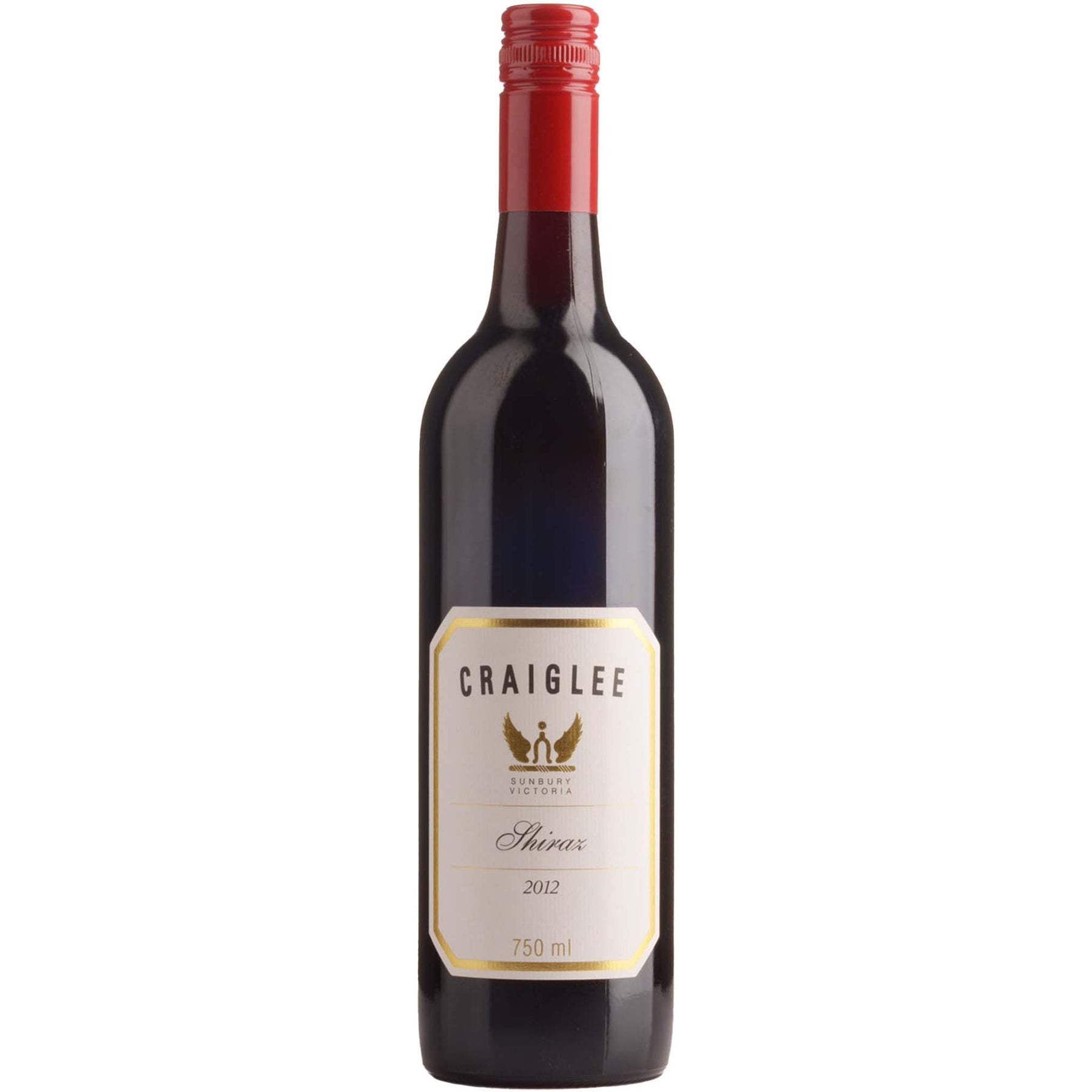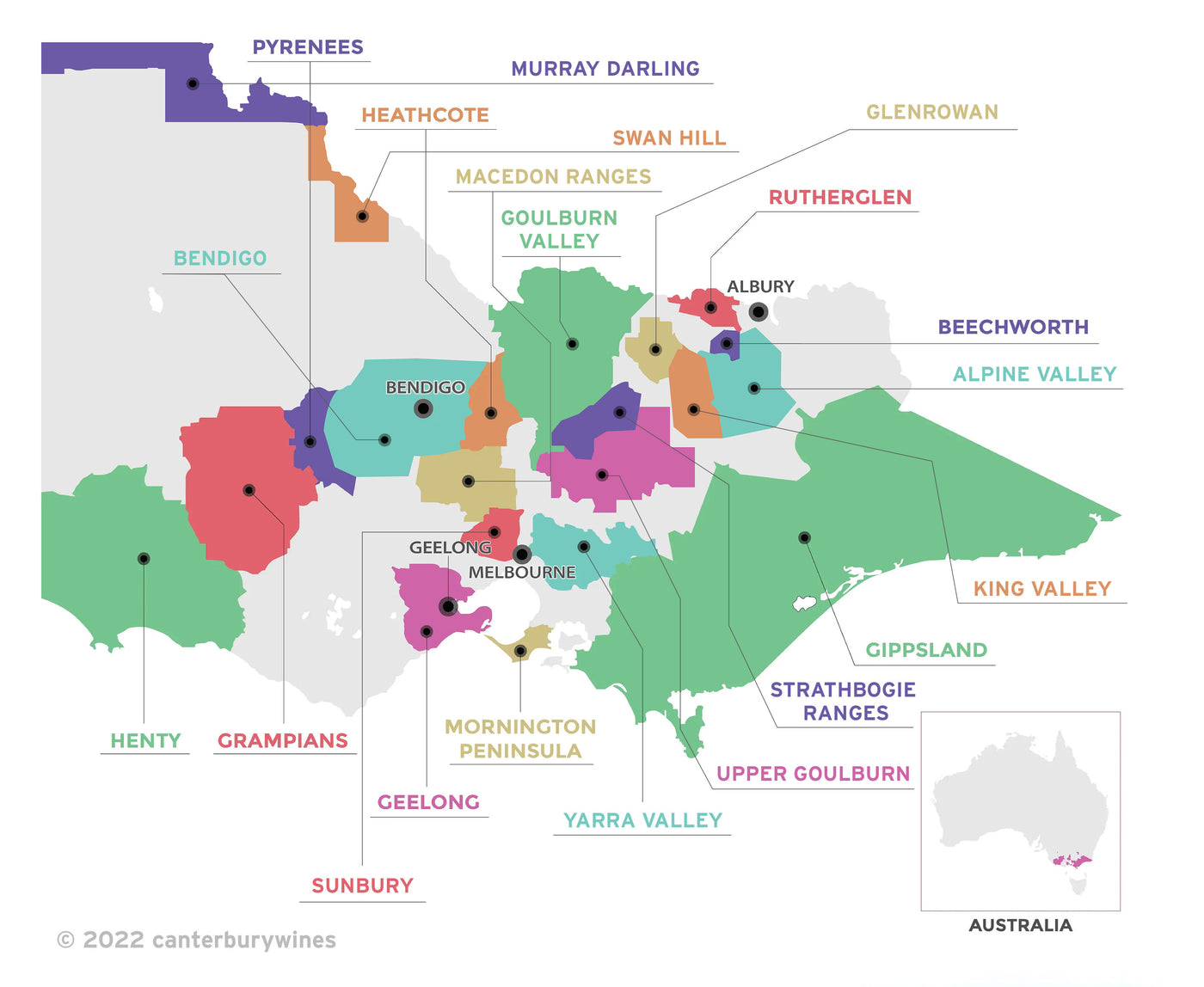

Craiglee Shiraz 2012
Style: Red Wine
Closure: Screwcap
Craiglee Shiraz 2012
Warehouse
34 Redland Drive
Vermont VIC 3133
Australia
Critic Score: 95
Alcohol: 13.5%
Size: 750 ml
Drink by: 2035
"Craiglee is a revered name among lovers of cool climate Australian shiraz, and rightly so." Campbell Mattinson
Craiglee is a small family run vineyard located in Sunbury on the outskirts of Melbourne that was established in the 1860s. It is one of Australia's oldest and most respected vineyards and produces one of the country's finest cool-climate shiraz.
"There is an almost pinot-like fragrance and delicacy to the bouquet of shimmering red fruits; the balance and mouthfeel of the light to medium-bodied palate is perfect, making the wine one of those with an almost indefinite drinking span, starting now." James Halliday
"One of Australia's great Shiraz producers, Pat Carmody carefully and quietly goes about his business crafting wines of wonderful balance, length and gentle power. The Shiraz is spicy and peppery with yummy squashed summer berry flavours and a savoury hint to finish. Overlook this cellar door at your peril." Ben Canaider
"'Any site anywhere in the world that can produce a wine that lasts for 100 years is worth being replanted,' said John Brown of Milawa fame after a cache of 1872 Craiglee Sunbury Shiraz was found buried at the winery in the 1950s. The 10 hectare vineyard – located on alluvial sands over river stones – is now over thirty-five years old. Vinification takes place in open cement fermenters. A small batch is partially barrel fermented. Maturation follows in new and old French and American oak for between 12 and 18 months. The wine is tightly structured with earthy, pepper, raspberry black olive characters and firm tannins; with age becoming more earthy, complex and loose-knit with softer tannins." Andrew Caillard MW
Expert reviews
"Relatively light but bright crimson-purple hue; there is an almost pinot-like fragrance and delicacy to the bouquet of shimmering red fruits; the balance and mouthfeel of the light to medium-bodied palate is perfect, making the wine one of those with an almost indefinite drinking span, starting now. Drink by 2032." James Halliday, Halliday Wine Companion - 95 points
"Great to see Craiglee Shiraz sealed with a screwcap. It’s grown of course on the Craiglee vineyard, planted in 1976. This release is light in colour and in fruit intensity and qualifies easily for "burgundian shiraz" status. Its charms are in its sling of tannin, its spice, in the taut elastic quality of its fruit. It’s not overly peppery but the first thing you notice is its savouriness. Red liquorice, dark cherries, a (thin) silk-like glove of oak. Medium-bodied, beautifully balanced and styled; it will age charmingly, and convincingly. Drink: 2017 – 2025+." Campbell Mattinson, The Wine Front - 94+ points
"Tasted just after bottling, this delicate but complete and evenly ripened shiraz has a subtle but deeply scented perfume of raspberries, cassis, black pepper and five spice underpinned by subtle notes of creamy vanilla oak. ItÕs long and gentle, with a smooth, finely crafted palate whose rather fragile presence of pristine cassis, raspberry and redcurrant flavour reveals nuances of dark plum and cedary oak. Underpinned by fine, supple tannins, it's likely to build considerably, appearing to have what it takes to be a worthy follow-up to the stunning 2010 vintage." Jeremy Oliver - 94 points
Pat Carmody

Craiglee owner and winemaker Pat Carmody
The following text is taken from an article by Campbell Mattinson at https://www.campbellmattinson.com, which won the $10,000 Australian Wine Communicator Award in 2005 (as judged by the late Len Evans).
The dogs roved by night. They poured over the rocky hills of Sunbury in southern Victoria, driving at sheep and slaughtering by the dozen. One night they got a sniff of a flock and chased it through the grass-splashed blackness, hoaring and gnawing and mincing at their heels, barking at the bleating, herding, terrifying, driving the sheep as a group. The night turned blacker, the land rose, the barking and bleating and bullocking reached the kind of windy pitch that makes people peer out from behind curtains. There was trouble that black night on the Carmody farm at Sunbury; the farm known as Craiglee.
It was the early 1970s. It was in the late, tired, mad stretch of night. The dogs charged and the sheep fled and in the morning in the lee of the craig it was a bloody horror, an incredible 150 sheep dead on the Carmody farm, the bulk of them rammed and herded and run straight off a cliff edge.
That night 'destroyed my father', winemaker Pat Carmody now says. That night was the reason Pat Carmody got to thinking that the family needed to farm something different, something that couldn't be destroyed by beasts in the night or, in Pat's words, 'something that couldn't be eaten'. In 1976 then, shiraz vines were planted on the family farm on the Tullamarine Airport side of the Sunbury township. It was an historic decision, on an historic site: a century before there'd been a vineyard on that very patch of land, and that vineyard had produced wines that, it turned out, lived a healthy life of a hundred years plus.
As land goes then, the Craiglee farm had breeding. Thirty years later, the Craiglee breeding seems truer than ever; the rejuvenated Craiglee vineyard now produces one of Australia's finest wines. Pat Carmody, modestly, attributes Craiglee's success 'not to the yield, and not to the age of the vines. I think that it all comes down to the quality of the site'.
Not that Pat Carmody's father wanted to have a bar of planting a vineyard when it was first suggested back in the 1970s, by (the late) John Brown of Brown Brothers. John Brown had been there the night that the 100-odd year old wine had been opened, and had been so taken by the wine that he'd driven out to Sunbury to visit. 'When John suggested that, my father thought it was a fair bit of nonsense,' Pat now says. 'But John was pretty keen: he reckoned that any vineyard that could produce a wine that drank well after a hundred years in the cellar had to have something about it.'
The Craiglee wine that started the modern renaissance came from 1872. Craiglee back then was run by a member of Victorian Parliament. Bottles of this wine survived because it had won an award at an exhibition in Vienna in 1875, and because of that win its proud-as-punch maker (the Johnston family) kept bottles of it aside. These bottles were kept, undisturbed, in the dark, in frigid conditions, in the property's bluestone Sunbury cellar. These set-aside bottles were uncovered in the early 1950s – prior to the Carmody's ownership of the property – and certainly well before the vineyard was replanted (in 1976). A good number of bottles of it were opened in the 1960s and again in 1972, to mark its centenary. To everyone's amazement, the wine was not just still good, but was beautiful.
Or, indeed, better than that. Some Australian wine industry people lucky enough to have drunk of it still, today, reckon that it was the most magnificent Australian wine they've ever encountered.
The romance of it.
At one showing of the wine, in the early 1970s, a Dr Simon Borten described this forgotten-then-found wine with these eloquent words: 'A rich, glowing wine with all oenological faculties unimpaired and a mouthful of bouquet to every sip. (It) has lost nothing by age, it was at its best, a wonderful claret, there are few wines of this century that can equal its magnificent flavour, gentle richness and mellowness. No wine could have been more enjoyable.'
This of course is some praise for a 100-year-old wine, which is why the details of this wine are now part of Australian wine folklore. What is less well known is that the wine in question, which drank well at 100 years of age, was made off tender young vines producing only their third crop. To boot, the wine had an alcohol content of around 11.5 per cent.
There is a theory that wines made from young grapevines cannot age long term. Another is that wines at low alcohol lack charm and flavour. This old Craiglee wine ruffles both theories.
More importantly, what this historic wine has done to Craiglee – and to Pat Carmody specifically – is give the estate a clear wine goal, and a goal that (critically) relates solely to the exact piece of land that he farms.
Everything Pat Carmody does is an attempt to tease out the kind of qualities that the land produced a century ago. As Pat puts it, 'I've always worked with the monkey on my back. Can I produce a wine that will live for 100 years?'
(Or more specifically, for 120 years: the one and only chance Carmody has had to taste the 1872 Craiglee shiraz was at a dinner organised by writer Andrew Wood, in 1992. There's an interesting story here too: when Pat saw the wine for sale at auction he planned to bid on it, but just before the auction his tractor blew up and he didn't have the time or money to go chasing wine. Wood bought it – and then invited Carmody over for dinner and a drink.)
This partly explains why, when people rave over Craiglee's warm-year 1997 and 2000 shiraz releases, Carmody is pleased but quietly circumspect. Personally, he prefers the cooler years, the finer years, the spicier years (Carmody can tell you which grapes, in which position on which vine, will carry spice flavours, and which grapes – before he's even tasted them – will have all the spice blown off). In short, he's keener on the releases that more reflect that historic 1872 vintage release.
I may not share his exact taste – the 1997 Craiglee shiraz, from a warm year, served at an international shiraz extravaganza in 2004, stole the show with its ripe, spice-shot elegance – you can't help but recognise that Carmody's taste is the key to understanding and appreciating Craiglee. Carmody's taste has depth, breadth and history. Egging this along is the fact that Carmody also believes that moderate years, rather than warm-to-hot years, have a tendency to live longer.
Not that Carmody, of late, has had too many of his preferred kind of years to play with, courtesy of the 1997-2007 drought. 'People talk about dry-grown vineyards,' Carmody says, 'but after ten years without proper rainfall, the de-vigoration in the vineyard here is scary. We're down to half a tonne per acre with our shiraz, which creates all sorts of viability issues.'
'It's important," Carmody moves on, "that you don't get too precious about your position (in Australian wine). It's very easy to become, or to be seen as, part of the furniture. You don't want to be in people's faces all the time, but it's sometimes hard to keep people interested.
"It's interesting for me to see the (winery) names who get the attention, and the areas that do: I look at the land here and know that this area has grown fruit for a long time, which means that it's a sustainable area. I'm not yet sure if some of these other (wine) areas are. I don't know if they are, is the honest answer, I don't know. I just work on the basis that if your wines are good enough then they'll make a name for themselves, and if they're not then you'll fade away.'
I say to Carmody, then, that when I spoke to him nearly two years prior, he'd talked against the idea of Craiglee creating a reserve wine. His reasoning was simple: he didn't like robbing Peter to pay Paul. In the meantime the wine world around him had moved progressively towards more exclusive parcels of grapes being kept separate in the winery and then bottled distinct. We've moved beyond reserve wines to single vineyard wines. We'll soon move to small-sections-of- a-vineyard wines. It's part of a keen drive within boutique Australian wine circles to showcase the best or most distinctive wine expressions the land can produce. It's part, in broader terms, of Australian wine's move away from a democratic ideal, and towards the niche elite.
'When we planted shiraz in the 1970s,' Carmody says, 'shiraz was unfashionable, so we don't mind if what we do is unfashionable. But look, in ten years' time, I don't know what we'll be selling. I like the way we've got things now. It's a simple message. And besides, I don't want to be so presumptuous as to pull out a barrel and sell it at a higher price. If I think it's good, I want to put it in with the others. But who knows?'
Who knows. The Craiglee winery exists because of a wine that remained true and beautiful for over 100 years, and for this truth and beauty it became a legend. The Craiglee winery exists, too, because of a night, a dark night, roved by dogs, when the farm's 150 sheep were run straight off the edge of a cliff. As histories go, the Craiglee one is dark, deep, vivid and magical. It's from this darkness, and this depth, and the vividness of this magic that the Craiglee wines do rise. We drink them, in or outside the lee of the craig, and know both in our hearts and in the cold centre of our bones, that truth and beauty are near.
About the winery
Craiglee is a small family run vineyard located in Sunbury on the outskirts of Melbourne that was established in the 1860s. It is one of Australia's oldest and most respected vineyards and produces one of the country's finest cool-climate shiraz. Vines were first planted in 1863 by James Stewart Johnston, a prominent Melbourne businessman and member of Parliament. He built a bluestone winery into a steep slope near his home and used gravity to help make and store the wines. Grapes were brought to the upper level by horse and dray, taken below to be crushed and fermented and fed into barrels in the lowest level of the building which offered perfect cellaring conditions. The cellars are still used today.
Johnston made wines on the site for over a decade and his 1872 Hermitage (Shiraz) won a number of international awards. His sons continued making wines at Craiglee into the 1920s when they decided to close the winery.
In 1972, a number of Johnston's 1872 Hermitage bottles were opened at a function in Melbourne. John Brown Sr. of Brown Brothers happened to be at the dinner and was so impressed by the 100-year-old vintage that he decided to visit the Sunbury site to see if it still existed. Here he encountered a young Pat Carmody working on his family farm on the site of the old Craiglee vineyard and suggested he consider replanting on the site.
Pat planted Shiraz and Chardonnay vines on the original site in 1976 and processed his first wine three years later. Today, over 40 years later, Pat continues to make wine from fruit grown, hand-picked and bottled at Craiglee. His approach to winemaking has been resolutely founded on a respect for the site's history, a dedication to craft and a commitment to producing wines that reflect the terroir of Craiglee.
The family-run winery prioritises sustainable practices, using the same bluestone winery that Johnston built 150+ years ago, as well as solar power, wastewater and methods that protect the soil structure, maintain carbon levels and benefit the surrounding environment.

Victoria
Victoria is home to more than 800 wineries across 21 wine regions. The regions are Alpine Valley, Beechworth, Bendigo, Geelong, Gippsland, Glenrowan, Goulburn Valley, Grampians, Heathcote, Henty, King Valley, Macedon Ranges, Mornington Peninsula, Murray Darling, Pyrenees, Rutherglen, Strathbogie Ranges, Sunbury, Swan Hill, Upper Goulburn and Yarra Valley.
Victoria's first vines were planted at Yering in the Yarra Valley in 1838. By 1868 over 3,000 acres had been planted in Victoria, establishing Victoria as the premier wine State of the day. Today, the original vineyards planted at Best's Wines are among the oldest and rarest pre-phylloxera plantings in the world.
Victoria's climate varies from hot and dry in the north to cool in the south and each wine region specialises in different varietals. For example, Rutherglen in the north is famous for its opulent Muscats and Topaque and bold reds, while the many cooler climate regions near Melbourne produce world class Chardonnay and pinot Noir. Victoria is truly a wine lover's playground.


